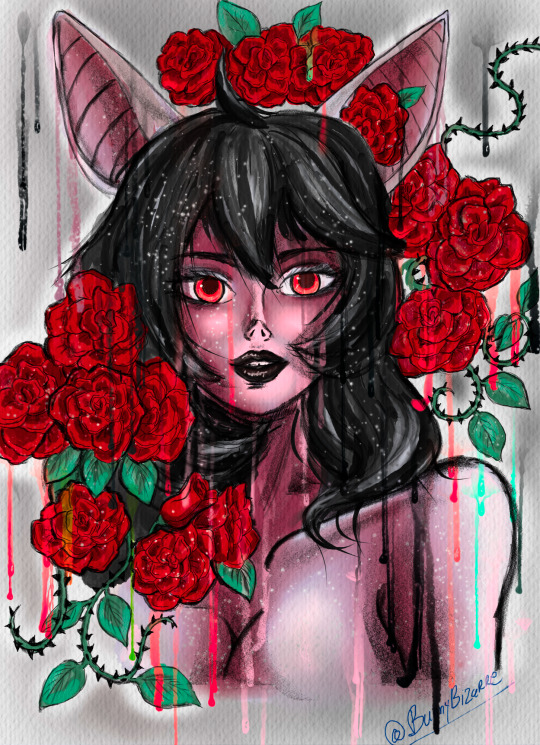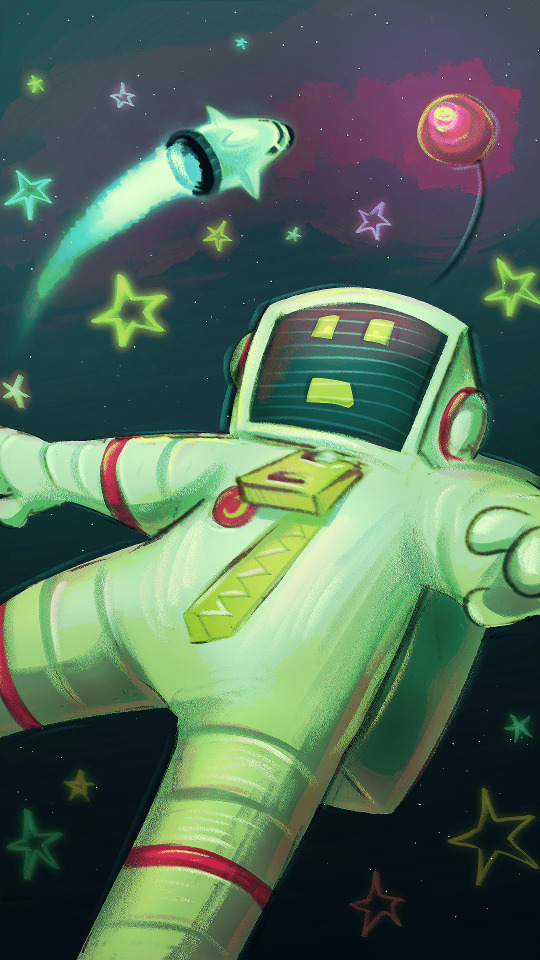Text

For my friend Luna
0 notes
Text


So happy about this one. Character by @Semlgrim (twitter)
0 notes
Text

quick cover drawing!! subject to change as the story progresses
305 notes
·
View notes
Text

"Murdered by Love"
#digital art#digital painting#digital illustration#artistontumblr#digital drawing#lovesick#sad thoughts
0 notes
Text
Narrative arcs/ plot structures that can be associated with misfortunes
In the previous post I listed some of the common misfortunes in the characters. In this post, I will give you several common narrative arcs or plot structures that can be associated with misfortunes.
The Hero's Journey: This is a classic narrative arc where the protagonist starts in their ordinary world, experiences a call to adventure or a significant misfortune, goes through a series of challenges and trials, and eventually returns transformed. The misfortune acts as the catalyst for the hero's journey, leading them on a path of self-discovery, growth, and eventual triumph.
Redemption Arc: In this plot structure, a character starts with a misfortune or a past mistake that haunts them. They embark on a journey of redemption, seeking forgiveness, atonement, or personal transformation. The misfortune serves as a driving force behind the character's quest for redemption and provides opportunities for reflection, self-improvement, and finding inner peace.
Overcoming Adversity: This plot structure focuses on a character facing a series of misfortunes or challenges and their journey to overcome them. Each misfortune serves as an obstacle or setback that the character must confront and find a way to overcome. This structure allows for exploration of resilience, determination, and the character's growth through their ability to persevere in the face of adversity.
Rise and Fall: This plot structure involves a character experiencing a series of misfortunes that lead to their downfall or a dramatic change in their circumstances. The misfortunes progressively escalate, leading to the character's ultimate downfall or a rock-bottom moment. This structure allows for exploration of themes such as hubris, consequences of actions, and the potential for redemption or downfall.
Quest for Justice: In this plot structure, a character faces a misfortune such as being wrongfully accused or witnessing an injustice. They embark on a quest to seek justice, uncover the truth, or make amends. The misfortune becomes the driving force behind the character's pursuit of justice, leading to a journey of investigation, moral dilemmas, and eventual resolution.
Tragic Arc: This plot structure follows a character who experiences a series of misfortunes that ultimately lead to their tragic downfall. The misfortunes progressively worsen, highlighting the character's flaws or weaknesses. The narrative explores themes of fate, the human condition, and the inevitability of tragedy.
Rebirth or Renewal: In this plot structure, a character undergoes a profound misfortune that serves as a catalyst for their personal transformation or rebirth. The misfortune forces the character to reassess their priorities, values, or beliefs, leading to a positive change in their life. The narrative focuses on themes of self-discovery, second chances, and finding hope amidst adversity.
Parallel or Interconnected Misfortunes: This plot structure involves multiple characters experiencing misfortunes that are interconnected or occur simultaneously. Their stories may intersect, intertwine, or influence one another, creating a complex narrative with multiple perspectives. This structure allows for exploration of themes such as interconnectedness, empathy, and the ripple effects of misfortune.
Betrayal and Revenge: This plot structure revolves around a character who experiences a betrayal or significant misfortune at the hands of someone they trusted. The misfortune fuels their desire for revenge, driving them to seek justice or retribution. The narrative delves into themes of betrayal, morality, and the psychological and emotional consequences of seeking vengeance.
Coming-of-Age: This arc focuses on a young character who undergoes a misfortune that forces them to confront the challenges of adulthood and mature emotionally. The misfortune becomes a transformative experience, leading the character to navigate their identity, make difficult choices, and discover their place in the world. Themes explored include self-discovery, resilience, and the transition from innocence to experience.
Episodic or Anthology Format: This structure involves a collection of standalone stories or episodes, each featuring a different character facing a distinct misfortune. The misfortunes may vary in nature and severity, showcasing a range of experiences and perspectives. This format allows for exploration of diverse themes, character development, and the interconnectedness of human experiences.
Psychological Journey: This narrative arc focuses on a character's internal struggle as they confront a misfortune that challenges their perception of reality or tests their sanity. The misfortune may be psychological in nature, such as delusions, hallucinations, or internal conflicts. The narrative explores themes of perception, identity, and the fragility of the human mind.
These narrative arcs and plot structures provide different frameworks for developing stories around misfortunes. They offer opportunities for character growth, thematic exploration, and engaging storytelling, allowing readers or viewers to connect with the characters and their experiences on a deeper level.
If you want to read more posts about writing, please click here and give me a follow!

208 notes
·
View notes
Note
Can you please make a post on How To Create A Good Main Character (hero/antihero)?
Specifically, how to avoid the instance where a secondary character stands out more/is more lovable?
How to create a good main character
Creating a compelling main character, whether they are a hero or an antihero, is crucial for engaging storytelling and capturing readers' imaginations. The protagonist serves as the driving force behind the narrative, and their journey and development shape the overall story arc. To create a good main character, consider the following elements:
Clear Goals and Motivations: Your main character should have well-defined goals and motivations that propel their actions throughout the story. These goals can be external (e.g., saving the world, solving a mystery) or internal (e.g., self-discovery, personal growth). By establishing strong desires and motivations, you give readers a reason to root for and invest in the character's journey.
Complexity and Flaws: A good main character should be multidimensional and have flaws or internal conflicts. Flaws make characters relatable and human, while internal conflicts add depth and complexity to their personality. These imperfections can drive the character's growth and create opportunities for compelling storytelling. You can give your main character a mix of qualities that seem contradictory at first glance. For example, they could be both confident and insecure, compassionate yet prone to anger, or intelligent but plagued by self-doubt. These contradictions create internal tension and intrigue, making the character more complex and realistic. Or you can also show that your main character has vulnerabilities and insecurities beneath their confident exterior. These vulnerabilities can be related to past traumas, fears, or personal weaknesses. By gradually unveiling these hidden vulnerabilities, you create opportunities for character growth and empathy from the reader.
Backstory and Depth: Providing a well-crafted backstory for your main character enhances their depth and allows readers to understand their past experiences, shaping their present identity. Consider their upbringing, past relationships, or significant life events that have influenced their worldview or shaped their personality. This backstory can influence their actions and decisions in the story.
Authenticity and Relatability: The main character should feel authentic and relatable to readers. Create a main character with whom readers can empathize and connect emotionally. Show their vulnerabilities, fears, and insecurities to make them relatable and human. This can also be achieved through realistic dialogue, relatable emotions, and identifiable struggles. By evoking empathy, readers will become emotionally invested in the character's journey and root for their success.
Growth and Development: A strong main character undergoes growth and transformation throughout the story. Allow your main character to face significant challenges and obstacles that require them to grow and evolve. These challenges can push the character out of their comfort zone, test their abilities, and force them to confront their flaws or fears. Through overcoming these obstacles, the character develops resilience, gains new insights, and undergoes personal growth. This character development also allows readers to witness their evolution and creates a sense of satisfaction or catharsis.
Moral Ambiguity: Avoid creating a main character who is purely good or evil. Instead, introduce moral ambiguity by giving them ethical dilemmas or conflicting values. This complexity can generate internal conflicts and force the character to make difficult choices that challenge their own sense of right and wrong. If you're creating an antihero as the main character, you need to consider exploring moral complexity. Antiheroes often possess morally ambiguous qualities, engaging readers by challenging traditional notions of heroism. Balancing their virtuous and flawed aspects can make them intriguing and thought-provoking.
Relationships and Dynamics: The main character's interactions with other characters can illuminate different facets of their personality. Show how their interactions with other characters influence their beliefs, values, and behaviors. As relationships evolve, the character may reveal different aspects of themselves or experience changes in their motivations and loyalties. Well-developed relationships, whether they are friendships, romantic entanglements, or rivalries, can contribute to the main character's growth and provide opportunities for conflict, resolution, or emotional impact.
Consistency and Growth Potential: It is essential to maintain consistency in their core identity and values. Readers should recognize the character's essential traits and motivations throughout the story. This consistency helps them form a bond with the character and creates a sense of authenticity. However, while a main character should have consistent traits and behaviors, there should also be room for growth and change. A compelling main character often goes through an inner journey or transformation alongside the external plot. They may have to confront their own flaws, learn valuable lessons, or undergo a change in their beliefs or values. This inner transformation adds depth and complexity to the character's development and resonates with the readers' own experiences of personal growth. Striking a balance between consistency and growth potential allows the character to maintain their core identity while adapting to the challenges they face.
Unique and Memorable Attributes: Give your main character distinctive qualities that make them stand out in the reader's mind. This could be a unique physical characteristic, a particular skill or talent, or a memorable personality trait. These attributes contribute to the character's individuality and make them memorable long after the story has ended.
External and Internal Conflicts: Introduce conflicts that challenge your main character both externally and internally. External conflicts can come in the form of obstacles, adversaries, or difficult circumstances that the character must overcome. Internal conflicts, on the other hand, delve into the character's inner struggles, such as their fears, doubts, or conflicting desires. Balancing these conflicts adds depth and tension to the character's journey.
Agency and Proactivity: Give your main character agency and the ability to drive the story forward. They should be active participants in their own fate, making choices and taking actions that shape the narrative. Passive characters who merely react to the events around them can be less engaging. Allow your main character to have a degree of control and influence over their destiny.
Inner Journey and Transformation: A compelling main character often goes through an inner journey or transformation alongside the external plot. They may have to confront their own flaws, learn valuable lessons, or undergo a change in their beliefs or values. This inner transformation adds depth and complexity to the character's development and resonates with the readers' own experiences of personal growth.
Subtle Complexity: Avoid creating one-dimensional characters by incorporating subtle layers of complexity. Consider giving your main character conflicting desires, ambiguous morality, or hidden depths. These nuanced qualities make the character more intriguing and provide opportunities for deeper exploration and reader engagement.
How to avoid the instance where a secondary character stands out more/ is more lovable?
Well, It's not uncommon for secondary characters to capture readers' attention and become beloved. However, if you want to ensure that your main character remains the focal point of the story and maintains reader engagement, consider the strategies I mentioned above. There are also some other strategies to keep in mind:
Clear Focus and Development: Give your main character a clear and compelling storyline that allows them to grow, change, and face significant challenges. Ensure that their journey is central to the plot and that their character arc is well-developed. This way, readers will be invested in the main character's progression and more likely to connect with them on a deeper level.
Unique Role and Purpose: Establish the main character's unique role and purpose within the story. Highlight their specific skills, abilities, or knowledge that set them apart from the secondary characters. Make sure that the main character's actions and decisions have a significant impact on the overall narrative, reinforcing their importance and making them indispensable to the story's progression.
Emotional Depth and Relatability: Develop the main character's emotional depth and relatability to forge a strong connection between readers and the character. Show their vulnerabilities, fears, and internal struggles. Allow readers to understand their motivations and experiences, creating empathy and investment in their journey.
Strong Characterization: Craft your main character with distinct and memorable traits, a unique voice, and a well-defined personality. Make sure they have their own quirks, strengths, flaws, and complexities that set them apart. This will help the main character stand out and make them more engaging to readers.
Balanced Screen Time: Ensure that the main character receives an appropriate amount of focus and screen time throughout the story. While secondary characters may have their moments to shine, make sure the main character's presence remains consistent and prominent. Avoid sidelining the main character for extended periods, as this can diminish their impact and reader engagement.
Unique Perspective: Offer readers a unique perspective through the main character's point of view. By delving into their thoughts, emotions, and perceptions of the world, you provide readers with a lens through which they experience the story. This unique perspective can set the main character apart and make them more engaging.
Here is some examples:
In the novel "To Kill a Mockingbird" by Harper Lee, the main character is Scout Finch. While Scout is the central protagonist, her father, Atticus Finch, serves as a beloved secondary character. Atticus is a wise and compassionate lawyer who takes on the defense of a black man falsely accused of rape. He embodies integrity, moral courage, and a strong sense of justice. Atticus is well-respected within the community and serves as a moral compass for Scout and her brother Jem.
Despite Atticus being a beloved character in his own right, the story maintains its focus on Scout's coming-of-age journey. While readers admire and connect with Atticus, it is Scout's perspective, growth, and experiences that drive the narrative forward. Atticus' presence enriches the story, but he doesn't overshadow Scout's development and the central themes of racism and empathy explored through her eyes.
Or in "Jane Eyre" by Charlotte Brontë, the main character, Jane Eyre, is an independent and strong-willed woman navigating societal expectations and personal growth. The secondary character of Mr. Rochester, the brooding and complicated love interest, adds depth and complexity to Jane's journey without overshadowing her development. Their relationship provides opportunities for Jane to assert her own values and principles.
In conclusion, secondary characters can add depth and richness to a story, and their popularity is not necessarily a negative aspect. A well-developed main character can coexist with beloved secondary characters as long as the main character remains the driving force of the narrative and maintains a strong connection with readers through their development, challenges, and unique role in the story.
I think if you create a good enough and impressive enough main character, your character will still be loved as usual, no matter how prominent the other characters are.
If you want to read more posts about writing, please click here and give me a follow!

266 notes
·
View notes
Text
Common misfortunes for characters
Death of a loved one: This can be a profound and devastating experience for a character, leading to grief, guilt, and a sense of loss. It can also serve as a catalyst for character development and exploration of themes such as mortality, coping with loss, and the fragility of life.
Serious illness or injury: Physical or mental health challenges can test a character's resilience and force them to confront their limitations. It can also provide opportunities for exploring themes of perseverance, the importance of support systems, and the fragility of the human body.
Loss of a job or financial ruin: Financial struggles can lead to desperation, uncertainty, and a loss of identity for a character. It can also present opportunities for growth, reinvention, and exploring themes of resilience, resourcefulness, and the true value of material possessions.
Betrayal by a trusted friend or ally: Betrayal can shatter trust and lead to feelings of anger, betrayal, and a loss of faith in others. It can create complex moral dilemmas for the character and explore themes of loyalty, forgiveness, and the dark side of human nature.
Imprisonment or wrongful accusation: Being imprisoned or falsely accused can lead to feelings of powerlessness, injustice, and a struggle for redemption. It provides opportunities for exploring themes of justice, personal agency, and the lengths one will go to prove their innocence.
Natural disasters: Natural disasters can be catastrophic events that disrupt lives, challenge survival instincts, and test a character's resilience. They can explore themes of human vulnerability, the power of nature, and the strength of community in times of crisis.
War or conflict: War and conflict can have profound impacts on characters, leading to physical and emotional trauma, loss of loved ones, and moral dilemmas. They provide opportunities for exploring themes of heroism, sacrifice, the futility of violence, and the long-lasting effects of war.
Addiction or substance abuse: Characters grappling with addiction or substance abuse can experience a downward spiral, strained relationships, and a loss of control. It allows for exploration of themes such as self-destructive behavior, the road to recovery, and the impact of addiction on oneself and others.
Mental health issues: Characters dealing with mental health issues like depression or anxiety can face internal struggles, isolation, and difficulties in functioning. It provides an opportunity to delve into themes of stigma, self-discovery, and the importance of mental health support.
Loss of a child or miscarriage: The loss of a child or experiencing a miscarriage can be emotionally devastating for characters, leading to grief, guilt, and questioning of one's purpose or identity. It allows for exploration of themes of parental love, coping with loss, and the complexities of grief.
Failed relationships or divorce: Characters going through failed relationships or divorce can experience heartbreak, loneliness, and a sense of failure. It presents an opportunity to explore themes of love, forgiveness, personal growth, and the complexities of human relationships.
Alienation or social isolation: Characters who feel alienated or socially isolated can grapple with feelings of loneliness, rejection, and a sense of not belonging. It allows for exploration of themes of identity, acceptance, and the importance of human connection.
Identity theft or fraud: Characters who fall victim to identity theft or fraud can face financial ruin, loss of reputation, and a struggle to reclaim their identity. It provides opportunities to delve into themes of trust, deception, and the lengths one goes to protect their identity.
Accidental injury or disability: Characters experiencing accidental injury or acquiring a disability can face physical and emotional challenges, adjusting to a new way of life, and overcoming societal barriers. It allows for exploration of themes such as resilience, self-acceptance, and the meaning of true strength.
Loss of a treasured possession or heirloom: Losing a treasured possession or heirloom can evoke feelings of loss, nostalgia, and a connection to the past. It provides an opportunity to explore themes of materialism, attachment, and the value of intangible memories.
Being stranded or lost in a remote or dangerous location: Characters finding themselves stranded or lost in a remote or dangerous location can face survival challenges, fear, and the need to rely on their instincts. It allows for exploration of themes of resilience, self-discovery, and the inherent strength of the human spirit.
Struggling with poverty or homelessness: Characters experiencing poverty or homelessness can encounter hardships, discrimination, and a constant struggle for basic needs. It provides an opportunity to explore themes of social inequality, resilience, and the power of compassion and empathy.
Encounter with a dangerous or malicious antagonist: Characters facing a dangerous or malicious antagonist can be subjected to physical and psychological harm, manipulation, and a fight for their lives. It allows for exploration of themes of good versus evil, moral choices, and the strength of the human spirit in the face of adversity.
Political or social persecution: Characters experiencing political or social persecution can face oppression, injustice, and the fight for their rights and freedom. It provides an opportunity to explore themes of social change, courage, and the power of collective action.
Being framed for a crime they didn't commit: Characters who are framed for a crime they didn't commit can face wrongful accusation, a loss of trust, and the pursuit of justice. It allows for exploration of themes of innocence, perseverance, and the search for truth.
These misfortunes can be used individually or combined to create layered and complex narratives where characters face adversity, overcome challenges, and ultimately find strength and growth through their experiences. Remember to balance the misfortunes with moments of resilience, hope, and eventual triumph to create a compelling narrative.
If you want to read more posts about writing, please click here and give me a follow!

3K notes
·
View notes
Text
Poison list
While it's important to approach writing with creativity and imagination, it's crucial to prioritize responsible and ethical storytelling. That being said, if you're looking for information on poisons for the purpose of writing fiction, it's essential to handle the subject matter with care and accuracy. Here is a list of some common poisons that you can use in your stories:
Hemlock: Hemlock is a highly poisonous plant that has been used as a poison in various works of literature. It can cause paralysis and respiratory failure.
Arsenic: Arsenic is a toxic element that has been historically used as a poison. It can be lethal in high doses and can cause symptoms such as vomiting, abdominal pain, and organ failure.
Cyanide: Cyanide is a fast-acting poison that affects the body's ability to use oxygen. It can cause rapid loss of consciousness and cardiac arrest.
Nightshade: Nightshade plants, such as Belladonna or Deadly Nightshade, contain toxic compounds that can cause hallucinations, respiratory distress, and even death.
Ricin: Ricin is a potent poison derived from the castor bean plant. It can cause organ failure and has been used as a plot device in various fictional works.
Strychnine: Strychnine is a highly toxic alkaloid that affects the nervous system, leading to muscle spasms, convulsions, and respiratory failure.
Snake Venom: Various snake venoms can be used in fiction as deadly poisons. Different snake species have different types of venom, each with its own effects on the body.
Belladonna: Also known as Deadly Nightshade, Belladonna contains tropane alkaloids such as atropine and scopolamine. Ingesting or even touching the plant can lead to symptoms like blurred vision, hallucinations, dizziness, and an increased heart rate.
Digitalis: Digitalis, derived from the foxglove plant, contains cardiac glycosides. It has been historically used to treat heart conditions, but in high doses, it can be toxic. Overdosing on digitalis can cause irregular heart rhythms, nausea, vomiting, and visual disturbances.
Lead: Lead poisoning, often resulting from the ingestion or inhalation of lead-based substances, has been a concern throughout history. Lead is a heavy metal that can affect the nervous system, leading to symptoms such as abdominal pain, cognitive impairment, anemia, and developmental issues, particularly in children.
Mercury: Mercury is a toxic heavy metal that has been used in various forms throughout history. Ingesting or inhaling mercury vapors can lead to mercury poisoning, causing symptoms like neurological impairment, kidney damage, respiratory issues, and gastrointestinal problems.
Aconite: Also known as Wolfsbane or Monkshood, aconite is a highly toxic plant. Its roots and leaves contain aconitine alkaloids, which can affect the heart and nervous system. Ingesting aconite can lead to symptoms like numbness, tingling, paralysis, cardiac arrhythmias, and respiratory failure.
Thallium: Thallium is a toxic heavy metal that can cause severe poisoning. It has been used as a poison due to its tastelessness and ability to mimic other substances. Thallium poisoning can lead to symptoms like hair loss, neurological issues, gastrointestinal disturbances, and damage to the kidneys and liver.
When incorporating poisons into your writing, it is essential to research and accurately portray the effects and symptoms associated with them. Additionally, be mindful of the potential impact your writing may have on readers and the importance of providing appropriate context and warnings if necessary.
If you want to read more posts about writing, please click here and give me a follow!

19K notes
·
View notes
Text
82K notes
·
View notes
Photo





Banana dolphin! Get it at my redbubble shop:
https://www.redbubble.com/i/sticker/Banana-Dolphin-Cute-Fruit-Animal-Marine-Fruits-Fruity-Animals-by-BunnyBizarre/144532668.EJUG5
2 notes
·
View notes
Photo




Hot dog dog! Get this desing at my redbubble shop:
https://www.redbubble.com/i/apron/Hot-Dog-Dog-Dachshund-Wiener-dog-Sausage-Dog-by-BunnyBizarre/145515723.6ZXWR
0 notes
Photo







Lime mice! Get this design at my redbubble shop:
https://www.redbubble.com/i/sticker/Lime-Mice-Fruit-Animal-Art-Lime-Mouse-Cute-Mice-by-BunnyBizarre/145516049.EJUG5
1 note
·
View note
Photo





Cauliflower sheep! Get it here:
https://www.redbubble.com/i/sticker/Cauliflower-Sheep-Food-Art-Vegetable-Animals-Veggie-Sheep-by-BunnyBizarre/145516248.EJUG5
0 notes




